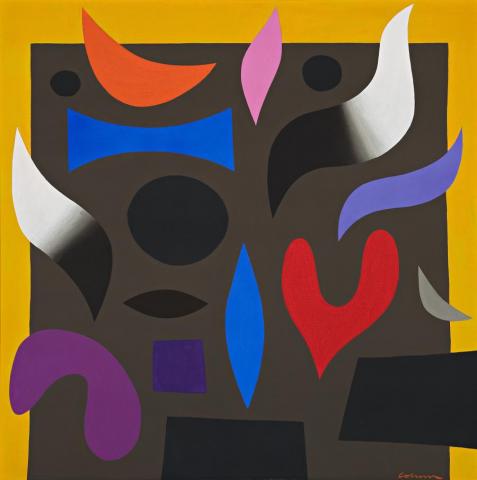TOWER OF BABEL, 1973
John Coburn
synthetic polymer paint on canvas
120.5 x 120.5 cm
signed lower right: Coburn, inscribed verso: JOHN COBURN / “TOWER OF BABEL” / SYDNEY 1973
Barry's Art Gallery, Surfer's Paradise
Private collection, Melbourne
In 1973, John Coburn's considerable international standing as a religious artist was confirmed by the commissioning of the painting Tree of Life III by the Vatican Museum's Gallery of Contemporary Religious Art. On the local front, he had been asked to design the poster for the Biennale of Sydney. The previous year, he was appointed Head of Sydney's National Art School; his curtains of the 'Moon and Sun' had just given added splendour to the interiors of the Sydney Opera House; and still in 1972, the Australian Government presented his 'Creation Series' of tapestries to the John F. Kennedy Centre for the Performing Arts, Washington. Given his many commitments, his large output of paintings for 1973 was amazing both for its quantity and quality. Coburn was at his creative height, a fact readily recognised by private and public collectors alike. The BHP Company acquired the large painting Garden in Vevey, and the National Australia Bank Fruits of Summer, while even larger paintings from that same year found their way into state and national art galleries - Queensland Art Gallery adding Valencia a few years later and Canberra's National Gallery of Australia acquiring Aubusson Green in 1992. Significantly, the present work Tower of Babel belongs to this richly fertile period.
All of Coburn's achievements celebrate colour - often at its purest, as seen in the reds yellows and blues of Tower of Babel. Primaries then morph into secondary oranges and mauves, while blacks and whites provide the cool contrast. Red was Coburn's favourite colour, used in the foremost shapes of birdlike forms of flight. As the colour temperatures cool, the forms recede to the neutrals apparent above the darker colourfield, hard edged by its surround of yellow-mustards. Depths vary and levels are intentionally ambiguous, allowing the viewer's imagination to come into play. Characteristically biomorphic and geometric, these floating forms have been refined to a simplicity that is arresting, as is their ability to express ideas profound and intuitive. As Coburn has said, 'My style is precise, clear and deliberate'.1 He also commented, 'I like all my shapes to be ambiguous so that people can read into them what they like.'2 The Book of Genesis tells us that God humbled the ancient builders of the Tower of Babel (with which they planned to reach the heavens) by confusing their language so that they could not understood each other. There are bold flyers a plenty in Coburn's painting; the reds rise, yet soon the whites slide into the blacks below. First dizzy heights recede through chosen symbols of colour and form.
1. John Coburn quoted in Klepac, L., John Coburn: The Spirit of Colour, The Beagle Press, Sydney 2003, p. 104
2. ibid.
DAVID THOMAS
